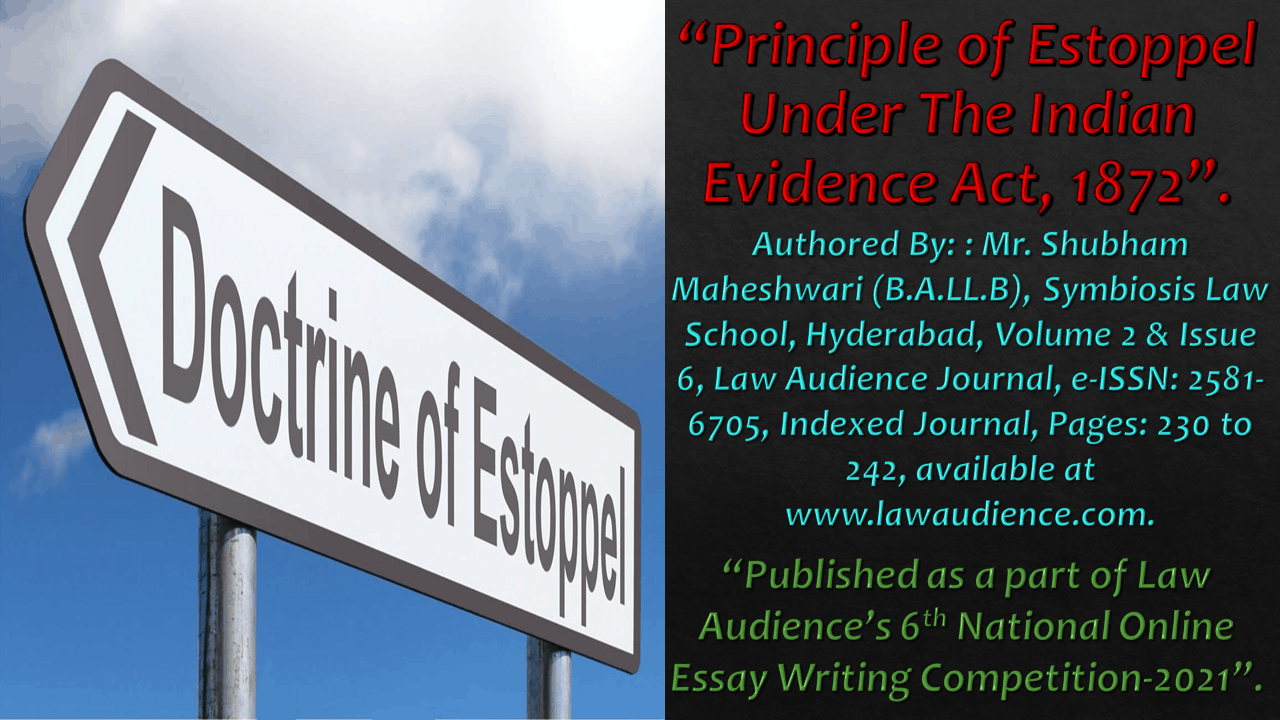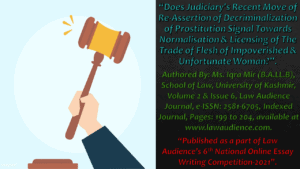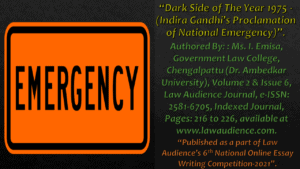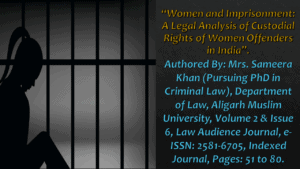Click here to download the full paper (PDF)
Authored By: Mr. Shubham Maheshwari (B.A.LL.B), Symbiosis Law School, Hyderabad,
Click here for Copyright Policy.
I. INTRODUCTION:
Estoppel is when a person has deliberately induced another person to believe and act on such a statement by actions or in any other way, neither he nor those defending him or her can deny the truth in a subsequent Court case.[1] In other words, estoppel prohibits someone from claiming something that runs counter to a claim made or previously carried out by that person. The accused does so by omission, deed or declaration. The word Estoppel derives from the maxim, “allegans contraria non-est audiendus,” which means that a person should not be heard claiming conflicting evidence, and is the species of “presumptio juris et de jure” in which the assumed truth is taken to be true against the party stating the same thing.[2]
Every single act draws repercussions for it, over the years the estoppel theory has evolved. It has been accepted as a federal entity. In Principle of Estoppel, in which a person induces another person to believe a fact through his words or conducts and then behaves according to that belief or to change his previous position, the accused is prevented from changing his position later on.[3]
Estoppel’s clause is provided for in Sections 115 to 117 of the Indian Evidence Act, 1872. According to the Act, Estoppel’s doctrine is that provision which prevents a person from giving false evidence by preventing them from making contradictory statements in a court of law. The purpose of this doctrine is to prevent one person from commissioning fraud against another. This doctrine holds a person responsible for his making false statements, either through his words or through his actions.
II. NATURE AND SCOPE OF ESTOPPEL:
The doctrine of estoppel is only applicable in those cases that which affect rights. It allows a party to go against another party to proclaim in the right of property which it did not in fact possess, is described as estoppel by negligence or by the conductor, by representation or by the ostensible authority being held out.[4] The nature of estoppel is often perceived to be a rule of evidence but in actuality, the entire nature of concept can be seen to be substantive in nature.
The concept of estoppel has no less than 3 aspects namely:
II.I Rule of Evidence:
The principle of Estoppel has some similarities to such a presumption of rule that cannot be questioned, and has often been so regarded as one of the consequences is to preclude another party’s supposed rebuttal of the truth. But an estoppel has two evidentiary features that differentiate it from rule of law.
II.II Matter of Pleading:
A party which proposes to depend on an estoppel firstly must raise this point, and then state the facts which is relevant in its pleading, subject to minor exceptions. This condition demands an exception so that the rule that evidence cannot be pleaded and also it does not show that it is not merely a rule of evidence.
II.III Substantive Law:
The estoppel doctrine is consider as substantive rather than adjective law. It is not considered on the similar basis as the Substantive Law. This is said, however, that they can help claims of equitable compensation and can constitute a defense if they prohibit a plaintiff from demonstrating those facts which are necessary for him.[5]
To apply the estoppel doctrine, the following conditions must be met:
- The representation must be rendered from one person to another.
- The representation made shall be as facts and not as rules.
- Representation as to an actual reality shall be made.
- The representation must be made in a manner which makes the other person believe that it is true.
- The person to whom the representation would be made should suffer a loss by such representation.
III. SCOPE OF ESTOPPEL UNDER THE ACT:
In Chhaganlal Mehta vs. Haribhai Patel[6], the Supreme Court stipulated that the eight requirements must be met in order to bring the case in a scope of estoppel framework as specified in Section 115[7].
- “A person (or his / her designated agent) must have served another person. Such a representation could be in any form— a sentence, an act, or an omission.
- Such portrayal must have been true, and not future promises or thoughts.
- The interpretation must have been obtained to rely on.
- Confidence on the part of the other party must have been in the facts.
- Any action must have been taken on the confidence of that sentence, act or omission. In other words, such a comment, behavior or omission must have in fact caused the other person to act on its confidence, and to change his position to his prejudice or disadvantage.
- The misrepresentation or actions or omission must have caused the other party to respond to its prejudice.
- The person claiming an estoppel’s gain firstly show that he does not have known about the authentic state of things. If the person has mean to known about the actual state of affairs, then there can be no estoppel.
- The doctrine can only be used by the person who’s the representation was made, or for whom it was built (or by his representative).”
In the landmark case of Sourujmull vs. Ganges Mfg. Co.[8], The court ruled as follows-
“The Courts here would then be debarred from entertaining any questions in the nature of estoppel which did not come within the scope of Sections 115 to 117, however important those questions might be to the due administration of the law.”[9]
IV. EVOLUTION OF ESTOPPEL:
The development of the doctrine of estoppel can be observed by its evolution in the English law and the Indian law. In the case of Hughes vs. Metropolitan Railway Co.[10], in this case, the land was leased by Hughes to conduct repair work by the Metropolitan Railway Company. The work must be completed by the defendants within months and if failed, it will amount to the forfeiture of the leased. The work is not completed within the time allotted. In this case, the court held that further time was extended to complete the work due to the application of doctrine of estoppel.
Doctrine of estoppel did not receive recognition even after the above case until when Lord Denning gave his judgment in the case of Central London Property Trust Ltd. vs. High Trees House Ltd.[11] The defendant leased the flat to the plaintiff in exchange for a specific sum of money. This number was reduced to half because of the outbreak of WWII. Even after the war ended, the defendant was paying half the amount. The court stated that it was implied that the reduced rate is limited to the time until the war continues, and thus the defendants are liable to pay full rent.
Thus, this estoppel doctrine in promissory and general estoppel was accepted in the India, in the case of Sourujmull and ors. vs. The Ganges Manufacturing Co.,[12] the court has laid down that the applicability of this doctrine is also applicable while applying in other circumstances in which an individual may be prevented from performing certain actions or wholly dependent on particular claims or arguments.
V. KINDS OF ESTOPPEL:
There are various kinds of estoppel as enumerated below:
V.I Estoppel by Matter of Record or Estoppel by Res Judicata:
Estoppel can only belong to the field of pure procedure more properly and is only dealt within the scope of Indian legislation.[13] Estoppel by Res judicata is also consider as a judgmental estoppel.[14] “Res judicata ousts the Court’s jurisdiction while estoppel merely shuts a party’s mouth.
V.I.I Estoppel and Waiver:
In the case of Dawsons Bank vs. Nippin Mekawa,
Lord Russell had made the distinction between an estoppel and waiver:
“Estoppel and waiver are entirely different. Estoppel is not a cause of action. It may, assist a plaintiff in enforcing a cause of action by preventing a defendant from denying the existence of same facts essential to establish the cause of action; on the other hand, waiver is contractual, and may, constitute a cause of action, it is an agreement to release or not to assert a right. There is no such thing as estoppel by waiver.”[15]
V.II Estoppel By Deed:
The estoppel law in which the contract binds the parties and those individuals which are arguing the deed through it. It is an exclusion contrary to the parties which are as they have signed the legitimate contract and refuse the rights of its force and also by any effect of inferior grandeur demonstration.[16]
V.III Estoppel By Matters in Paiis:
“Estoppel by matters in Paiis” (also, pais) is defined under Blackstone as an “assurance transacted between two or more private persons in pais, in the country, that, is, upon the very spot to be transferred”.[17]
Estoppel in paiis is firstly, from contract or agreement; secondly, regardless of contract, action or misrepresentation behavior having a modification of position in accordance through the apparent or real intentions of the party contrary to when the estoppel is assumed.
V.IV Equitable Estoppel:
Modern law of estoppel is indebted greatly to the theory of equity that is based on contract events or contract-like relationships combined with parties ‘ representations by a motion, act, or omission.
In this country, estoppels which is not govern under the statute law may be only considered equal estoppels.[18]Having made a promise in such a situation, the creator of it is prohibited from resiling from it.[19]
V.V Proprietary Estoppel:
It is legal precedent which forbid the party to reject his right in the property of the first party that another party has. “This theory was not only used to give influence to assurances that someone would be left with property in the future.[20] “In the case of Cobbe vs. Yeoman’s Row Management[21], attention was given to the fundamentals of proprietary estoppel and held that Cobbe was unable to make a proprietary estoppel claim.
V.VI Promissory Estoppel:
Legally implementing a vow. Made to the promisee by words or actions without knowing the disadvantage it may cause. This estoppel does not fall within the ambit of Section 115 as it deals with future promises.[22]
VI. DIFFERENCE BETWEEN ESTOPPEL AND RES JUDICATA:
| S.no. | ESTOPPEL: | RES JUDICATA: |
| 1 . | It prevents a person from telling one thing at a time and from telling opposite of it at another. | It forbids the competent jurisdiction of the court, between the same parties, on the matter already determined by the competent court on the same subject. |
| 2 | Estoppel is Equity law. | Res judicata is the rule of law. |
| 3 | Estoppel originates from representation or conduct of the party. | Res Judicata Has arisen from court decision. |
| 4
|
Estoppel prohibits a person from rebutting what he has argued | Res Judicata Prohibits the court from hearing a case that has already been clearly a competent court of jurisdiction.
|
| 5 | Estoppel shuts party mouth | Res judicata Shuts civil authority.
|
| 6 | Rules of estoppel are provided under Sections 115 to 117 of Evidence Act, 1872. | The rule regarding
res judicata are given under section 11 of C.P.C. 19o8.
|
| 7 | Estoppel may be derived from the parties ‘ actions | Res judicata is asserted on the basis of the competent court’s previous decision |
VII. ESTOPPEL UNDER INDIAN EVIDENCE ACT:
Under certain conditions, the law for estoppel of certain facts, such as between licensee and licensor, tenant and landlord[23], or as between the drawer and acceptor bill of exchange, between bailor and bailee[24]. Estoppel is a method to prove.
The Indian Evidence Act, 1872states:
“When one person has, by his declaration, act or omission, intentionally caused or permitted another person to believe a thing to be true and to act upon such belief, neither he nor his representative shall be allowed, in any suit or proceeding between himself and such person or his representative, to deny the truth of that thing”.[25]
In the case of Pickard vs. Sears[26], “It was allowed to remain in the possession of the mortgage against whom the judgment was rendered by the mortgagor. When the machinery was confiscated in action, although the mortgagee spoke to the judgment creditors but he did not mention the fact that the machinery in which he had an interest had been seized to pay for another man’s debt, it was held that he cannot claim back the equipment because his action constitute the willing representation.”
Section 115 ingredients are hereafter, viz;
- There has to be a certain representation.
- The representation shall be made with the intention to act upon it.
- They must have relied on the description.
- This action would have had to be of unfavorable to the interests of the person who made the representation.
Four forms of estoppel are to be found in sections 116 and 117 of the Act, i.e.,
VII.I Tenant:
The tenant is not allowed to dispute of the immovable property (or person claiming to be by such tenant), during the duration of the tenancy, that the proprietor of such tenant had a right to such immovable property at the beginning of the tenancy.
VII.II Licensee of A Person in Possession:
The person who claims the person’s license on immovable property in its session may deny that at the time such a license was issued, such person had a title to such possession.
VII.III Acceptor of A Bill of Exchange:
The acceptor cannot deny the authority on bill of exchange of drawer in drawing or endorsing such bill; but acceptor can dispute that when the bill was actually drawn by the person it purports to have been drawn by.
VII.IV Bailee or Licensee:
Licensee or Bailee cannot deny that his bailor or licensor was authorized to make any bailment or grant any license at the time when the license or bailment began.
As in the case where Supreme Court the position in Mohan vs. State[27], “the rule of issue does not preclude evidence given in one trial against the accused from being given in another trial for another offense”.[28]
VIII. WHEN ESTOPPEL IS NOT ATTRACTED:
In case of S. Sethuraman vs. R. Venkataraman[29], initially the litigant with respect to his promotion submitted himself to jurisdiction of the appellate authority (Joint School Education Director) but later challenged the judgment of it. The Supreme Court in these situations held that it would not hinder the appellant.[30]
VIII.I Estoppel in Criminal Cases:
Estoppel is a civil-action law. Therefore, estoppel in criminal proceeding has no significance, although in matter of such proceedings that cause an estoppel in civil actions are generally so logical and convincing that making up a different story would be almost useless.
VIII.II Estoppel should be pleaded: onus of proving the Plea:
The doctrine of estoppel relies on some evidence for its implementation.[31] Therefore, the estoppel ought to be expressly pleaded except when the ability to do so is not there. A person has right to plead estoppel but only in his own personal character, not as the representative of his appointed.[32] The estoppel does not apply when a party know the actual truth and cannot be fooled by false statement.
IX. SUGGESTIONS AND CONCLUSION:
Estoppels are objects of limitless scope in the way that there is no context are confined to subjects covered under Chapter VIII of the act. Words or actions, may render a picture. Even if the interpretation needs to be explicit and clear, a representation of silence may be inferred when there is a requirement to speak or inaction when a care obligation arises. Under English law, Estoppel usually protects by reflecting the facts, but it may be pro-active or counter-claimable. Estoppel has once been viewed as a statute or outlet of the proof law; the strongest view now is that it is a branch of the substance regulation more accurately. Though it may be considered within the field of practice in some respects. Nevertheless, it is normal in any situation to deal with the subject of evidence and, of course, it falls within the scope of our plan to deal with it in relation to evidence issues when estoppel is involved in a particular case. The theory of estoppel problem is further suggested to be established and codified by amendment of the Code of Criminal Procedure, 1973. It is therefore argued that Section 300-A may be added after Section 300 of Code of Civil Procedure, 19o8 to the effect that, if a matter has eventually been settled between the same parties, no fresh proof will be admissible in the preceding trial to prove such an issue.
With regard to the suggestion of the convergence of various estoppel rules, it is stated that different types of estoppels are valid in different areas of law. It’s true that the core element of all kinds of estoppel is to prevent unconscionable behaviour, they vary in nature. Additionally, the ingredients of different estoppel forms are not the same. Therefore, it is unlikely that a single Estoppel theory as suggested by Lord Denning would arise in the near future.
Footnotes:
[1] H.K. SAHARAY, M. MONIR’S LAW OF EVIDENCE 1863 (11 ed. Universal Law Publishing, 2006).
[2] RATANLAL & DHIRAJLAL, THE LAW OF EVIDENCE 609-654 (21 ed. Universal Law Publishing, 2009).
[3] Municipal Corporation of Bombay v. Secretary of State, 1904 29 (Bom) 580 (India).
[4] B.L.Shreedhar v. K.M. Mhmarireddy, AIR 2003 SC 578 (India).
[5] Robert N Moles & Bibi Sangha, Estoppel and its Origin forms, NETWORKED KNOWLEDGE (March 5, 2021, 10:00 AM) http://netk.net.au/Contract/o7Estoppel.asp.
[6] Chhaganlal Mehta v. Haribhai Patel, (1982) 1 S.C.C. 223 (India).
[7] The Indian Evidence Act, 1872, §115, No. 01, Acts of Parliament, 1872 (India).
[8] Sourujmull and ors. v. The Ganges Manufacturing Co., (1880) ILR 5 Cal 669 (India).
[9] Id. at para 14.
[10] Hughes v. Metropolitan Railway Co., UKHL 1, 2 AC 439.
[11] Central London Property Trust Ltd. v. High Trees House Ltd., [1947] KB 130.
[12] Sourujmull and ors. v. The Ganges Manufacturing Co., (1880) ILR 5 Cal 669 (India).
[13] Civil Procedure Code, 1908, § 11-14, No. 05, Acts of Parliament, 1908 (India).
[14] Bhagwati Prasad Sah v. Radha Kishun Seth, AIR 1950 P 354 (India).
[15] Dawsons Bank v Nippin Mekawa, (1935) 37 BoMLR 544 (India).
[16] Chhaganlal Mehta v. Haribhai Patel, (1982) 1 S.C.C. 223 (India).
[17] WILLIAM BALCKSTONE, BLACKSTONES’S COMMENTARIES 294 (1st ed. oxford University Press, 2016).
[18] Rup Chand Ghosh v. Sarveswar Chandra, (1906) 33 Cal 915 (India).
[19] N. Bhubaneswar Rao v. Principal, osmania College, Hyd., AIR 1986 AP 196 (India).
[20] Jaikaran Singh v. Sita Ram, AIR 1974 P 364 (India).
[21] Cobbe v Yeoman’s Row Management, [2008] 1 W.L.R. 1752.
[22] Chitranshul Sinha, The Doctrine of Promissory Estoppel – Application to the Government, LEGAL SERVICE INDIA (5 March, 2021, 11:30 AM), http://www.legalserviceindia.com/article/l249-Promissory-Estoppel.html.
[23] The Indian Evidence Act, 1872, §116, No. 01, Acts of Parliament, 1872 (India).
[24] The Indian Evidence Act, 1872, §117, No. 01, Acts of Parliament, 1872 (India).
[25] The Indian Evidence Act, 1872, §115, No. 01, Acts of Parliament, 1872 (India).
[26] Pickard v. Sears, (1837) 6 Ad &EL 469.
[27] Mohan v. State, AIR 1968 SC 1281 (India).
[28] Id.
[29] S. Sethuraman v. R. Venkataraman, (2007) 6 SCC 382 (India).
[30] Id. at 392.
[31]Sheo Tahal Ram v. Binaek Shukul, AIR 1931 All 689 (India).
[32] C.K. Mehta v. Patel narandas Haribhai, AIR 1983 (9) SC 119 (India).
Bibliography:
Books:
- BATUK LAL, THE LAW OF EVIDENCE 162 (22ed. Central Law Agency, 2018)
- K. SAHARAY, M. MONIR’S LAW OF EVIDENCE 1863 (11 ed. Universal Law Publishing, 2006).
- RATANLAL & DHIRAJLAL, THE LAW OF EVIDENCE 609-654 (21 Universal Law Publishing, 2009).
- WILLIAM BALCKSTONE, BLACKSTONES’S COMMENTARIES 294 (1st oxford University Press, 2016).
Journal Articles:
- Sweatha Kasi & Arya R, An Analysis Of Section 115 of Indian Evidence Act, 120 INT’L J. PURE APPL. MATH 29, 31-32(2018).
- Yuvraj Rathore & Shaurya Singh Rathore, The Doctrine of Estoppel As A Rule of Evidence: An overview, INT’L J. LEGAL DEV. & ALLIED ISSUES 231, 232-233(2019).
III. Internet Sources:
- Anjali Dhingra, Doctrine of Estoppel under the Indian Evidence Act, 1872, I PLEADERS (5 March, 2021, 11:30 AM), https://blog.ipleaders.in/doctrine-of-estoppel-in-the-indian-evidence-act.html.
- Anushka, Doctrine of Estoppel, LAW TIMES JOURNAL (5 March 2021, 2:00 AM), http://lawtimesjournal.in/doctrine-of-estoppel.html.
- Arvind Thapliyal and Kunal Kumar, India: Doctrine of Estoppel: overview, MONDAQ (5 March 2021, 01:00 AM), https://www.mondaq.com/india/Real-Estate-and-Construction/262648/Doctrine-of-Estoppel-overview.html.
- Chitranshul Sinha, The Doctrine of Promissory Estoppel – Application to the Government, LEGAL SERVICE INDIA (5 March, 2021, 11:30 AM), http://www.legalserviceindia.com/article/l249-Promissory-Estoppel.html.
- Piyush Jain, Doctrine of Estoppel: An Analysis, LEXQUEST PLEADERS (5 March, 2021, 11:40 AM), https://lexquest.in/doctrine-of-estoppel-an-analysis/.html.
- Robert N Moles & Bibi Sangha, Estoppel and its Origin forms, NETWORKED KNOWLEDGE (March 5, 2021, 10:00 AM) http://netk.net.au/Contract/o7Estoppel.asp.
- Ruth Hughes, Proprietary estoppel: looking both forward and back after Thorner v Major, STEP (5 March 2021, 11:30 AM), http://www.step.org/proprietary-estoppel-looking-both-forward-and-back-after-thorner-v-major.html.
- Saumya Chowdhary, Doctrine of Estoppel, LEGALBITES (5 March, 2021, 11:50 AM), https://www.legalbites.in/estoppel-doctrine.html.
- Suyash Verma, Doctrine of Waiver and Constitution of India, DESI KANOON- LAW, ECONOMICS AND POLITICS (March 5, 2021, 11:00 AM), http://www.desikanoon.co.in/2014/05/constitutional-law-doctrine-of-waiver.html.
Cases:
- L.Shreedhar v. K.M. Mhmarireddy, AIR 2003 SC 578 (India).
- Bhagwati Prasad Sah v. Radha Kishun Seth, AIR 1950 P 354 (India).
- K. Mehta v. Patel Narandas Haribhai, AIR 1983 (9) SC 119 (India).
- Central London Property Trust Ltd. v. High Trees House Ltd., [1947] KB 130.
- Chhaganlal Mehta v. Haribhai Patel, (1982) 1 S.C.C. 223 (India).
- Cobbe v Yeoman’s Row Management, [2008] 1 W.L.R. 1752 .
- Dawsons Bank v Nippin Mekawa, (1935) 37 BoMLR 544 (India).
- Hughes v. Metropolitan Railway Co., UKHL 1, 2 AC 439.
- Jaikaran Singh v. Sita Ram, AIR 1974 P 364 (India).
- Municipal Corporation of Bombay v. Secretary of State, 1904 29 (Bom) 580 (India).
- Mohan v. State, AIR 1968 SC 1281 (India).
- Bhubaneswar Rao v. Principal, Osmania College, Hyd., AIR 1986 AP 196 (India).
- Pickard v. Sears, (1837) 6 Ad &EL 469.
- Rup Chand Ghosh v. Sarveswar Chandra, (1906) 33 Cal 915 (India).
- Sethuraman v. R. Venkataraman, (2007) 6 SCC 382 (India).
- Sheo Tahal Ram v. Binaek Shukul, AIR 1931 All 689 (India).
- Sourujmull and ors. v. The Ganges Manufacturing Co., (1880) ILR 5 Cal 669 (India).
Statutes:
- Civil Procedure Code, 1908, No. 05, Acts of Parliament, 1908 (India).
- The Indian Evidence Act, 1872, No. 01, Acts of Parliament, 1872 (India).
Cite this article as:
Mr. Shubham Maheshwari, Principle of Estoppel Under The Indian Evidence Act, 1872, Vol.2 & Issue 6, Law Audience Journal, Pages 230 to 242 (30th June 2021), available at https://www.lawaudience.com/principle-of-estoppel-under-the-indian-evidence-act-1872/.



